Pioneer VSX-LX503
Product Name: Pioneer VSX-LX503
Product Description: 9.2 CH 4K AV Receiver
-
Design - 9/10
9/10
-
Audio Quality - 9.2/10
9.2/10
-
Inputs / Ports - 9/10
9/10
-
OS, Apps and Features - 9.2/10
9.2/10
-
Price / Quality - 8.8/10
8.8/10
Summary
Total Score
Pros
- Very good sound quality
- Good amount of features and settings
- Can expand to 11 channels with external amp
Cons
- Not many ports compared to other models
- No backlight remote
- Tough competition in this price range
Cheapest Places to Buy :
*We are a reader-supported website. When you buy through links on our site, we may earn a small affiliate commission at no extra cost to you. Home Media Entertainment does not accept money for reviews.*
A few months ago Pioneer announced we would be getting a couple of new mid-ranged AV receivers that would come equipped with 9 channels of amplification as well as support for all the new audio formats. It seems like the time has come for 9.2 channels AV receivers to cost under $1000 and the two new receivers from Pioneer are a good example of this new trend that seems manufacturers are starting to follow. Just a few years ago it would be unimaginable to get a 9.2 channels AV receiver for under a grand so it is exciting to see prices going down so aggressively and this means only good things for the consumers.
One of these new models is the one we will be reviewing here today. Pioneer is a very respectable brand in the home theater electronics segment having produced some very fine equipment over the last few years so we were curious to see how these new models will perform especially when you consider that we are talking about a middle tier AV receiver. So without further delay let’s start our Pioneer VSX-LX503 review.
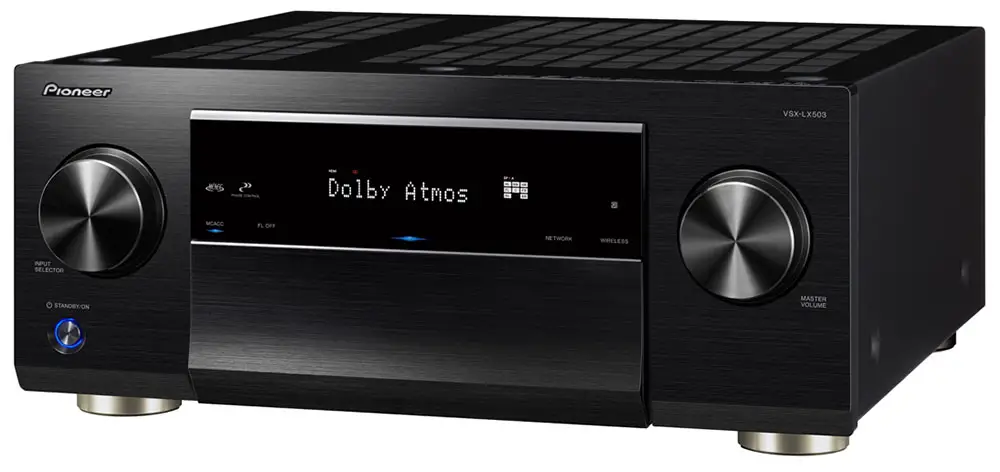
Design
Pioneer went for a very minimalism design with the VSX-LX503 something that we definitely like. The body of the receiver has a brushed metal finish while the front side is aluminium based. The receiver comes in two colors, black and premium silver. Measuring at (W x H x D) 17.1” x 7.3” x 15.2” (435 x 185 x 386 mm), LX503 is a big AV receiver but not the biggest we have seen. There have been a few models we have tested here in the past that far exceeded the size we get here and for a 9.2 channels receiver we would say it is normal to be as big as this.
In the front there are two big turning knobs, one at each side. The right one for the volume and the left for the input selection. Under the left knob is a small power button that has a very nice blue led around it and looks great in low light conditions. In the middle we have the functions display with all the necessary information and under it we get a drop down panel door that hides a lot of control buttons as well as a few front connection ports.
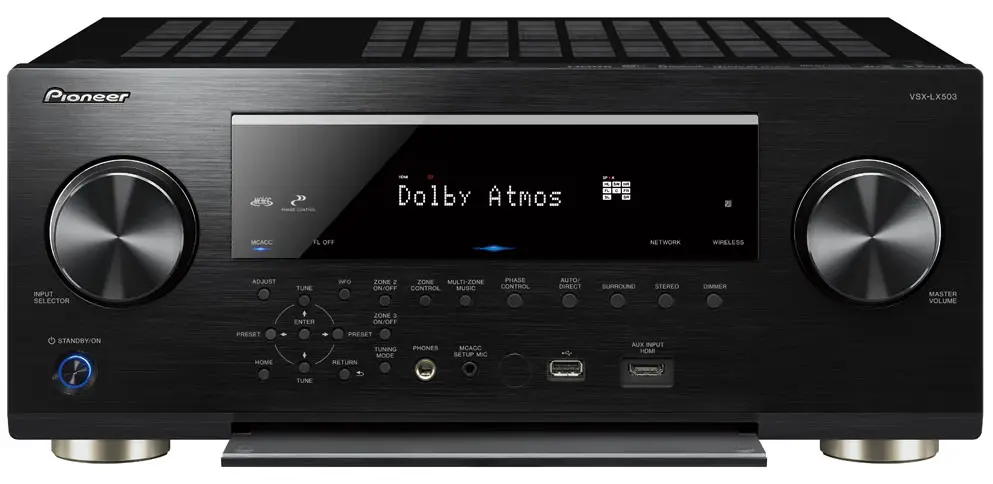
There are no other buttons visible outside the front panel door and this definitely helps the overall design of the receiver. But once you open the door you will find a big array of buttons that you can use for menu and setup navigation as well as many other functions like zone 2 control, phase control, surround, dimmer, stereo as well as menu and settings navigating buttons. Very few will actually use these buttons but it is definitely good to have them in case they are needed.
Under the hood the VSX-LX503 is equipped with a digital Quad-Core 32-bit DSP from Cirrus Logic as well as an Aureus Floating-Point DSP from Texas Instruments. We also find 384 kHz/32-bit DACs with AK4458 (AKM) and PCM5101 (Texas Instruments). Pioneer knows how to choose components that will power their receivers but although in paper everything sounds great putting the VSX-LX503 to the test will reveal how truly good is this model.
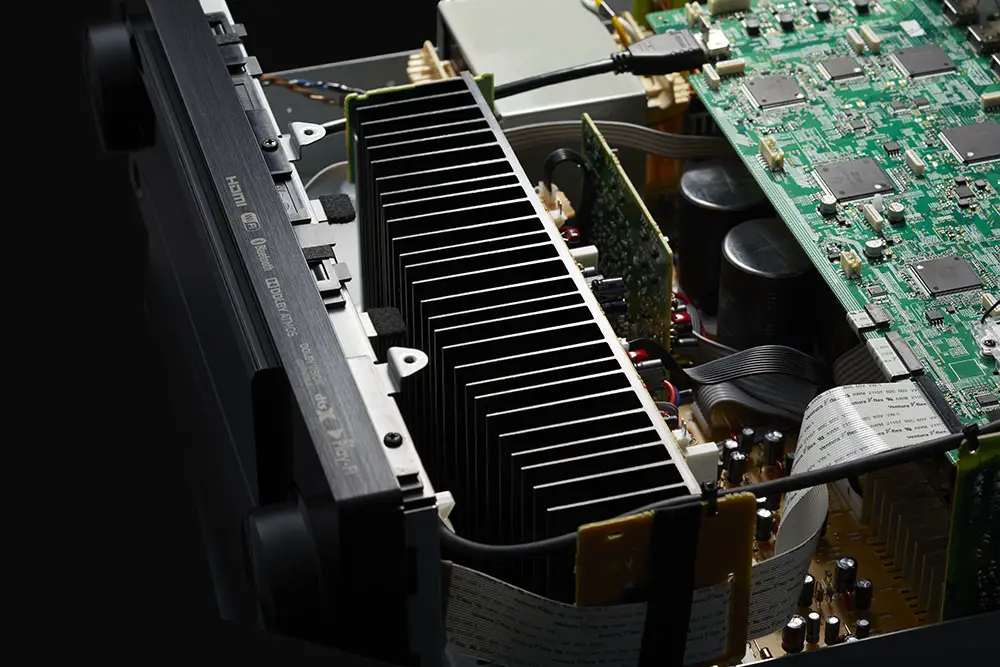
Audio Quality
Pioneer VSX-LX503 comes with nine channels of built-in amplification and a power of 120W per channel that is enough to power middle sized rooms and create a really encompassing sound field. With it’s nine channels you can go for either a 7.2.2 channels setup with two height speakers or for a 5.2.4 setup with four height speakers for even more accurate Dolby Atmos or DTS:X sound separation of the overhead layer. In our case we went for a 5.1.4 setup as we believe that four height speakers combined with a good audio mix that takes advantage of the overhead speakers can offer higher immersion than any 7.1 channels setup.
After going through the initial connections and setting up our speakers we chose as always our copy of Pacific Rim: Uprising for testing. We popped the disc in our Panasonic 4K UHD player and chose a few pre-selected scenes as we always do in this situations. Pacific Rim: Uprising may not be the greatest of action films but it’s Dolby Atmos track is nothing short of spectacular offering not only non-stop action but also immersive calm scenes full of ambient and environmental sound effects as well as dialogue driven moments making it ideal to try how an AV receiver handles each situation.
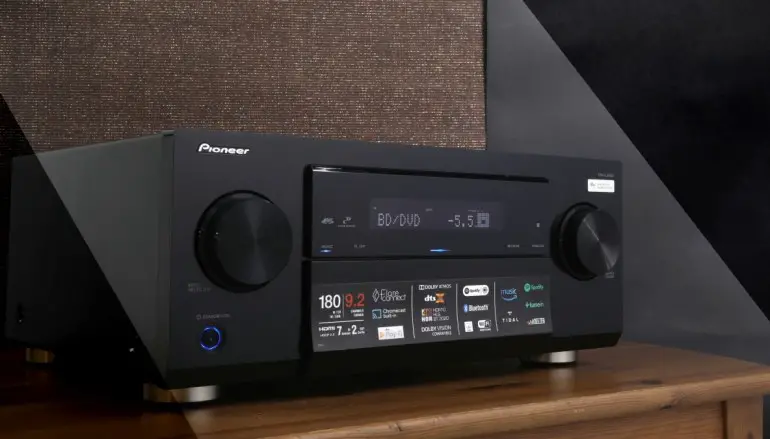
The VSX-LX503 performed admirably in all scenes that we tested it by offering very distinct separation of both the front and surround speakers while height speakers managed to expand the immersion bubble way above our heads creating a really impressive result. In heavy action scenes the receiver had all the necessary power that will make even demanding audiophiles happy and will definitely make a few walls shake. The center channel delivered very clear dialogue with good separation from the rest of the channels.
During the beginning of the film we are inside an old Jaeger scrapyard and you can hear various metal sounds from all over the environment making you feel like you are really there. On the contrary during the final act when the Jaegers fight the Kaijus all speakers go into overdrive. Mechanical sounds, projectiles flying all over the place, electronic effects from virtual cockpits and electronic equipment bleeping, there is so much audio information going on but the receiver manages to keep a tight control over this cinematic cacophony and delivering an exceptional performance.

The receiver may support the latest object-oriented sound formats but it is also equipped with a couple of technologies that would create a pseudo three dimensional sound field from other audio formats. Dolby Surround and DTS Neural: X upmixing are able to take audio signals that don’t support surround sound and upmix them in order to create a more immersive audio experience. Of course to do so it is a given that your system must have dedicated surround speakers and even better height speakers also. This way the system can create sounds from the original track in order to give you the sense of surround sound when originally there is none. The result depends a lot on the original audio track and although it may not reach the quality and clear surround sound separation of a true object-oriented audio track it is a good alternative in these situations where an audio track does not have any surround sound.
Our main focus may be movies audio reproduction but we should not forget that many people are using these receivers to get their music fix so in this regard we also tested a few reference songs to see how it fairs. In all honesty we were very impressed with the receiver delivering a very clear and dynamic performance. Bass was filling the room with it’s strong presence and the receiver gave you a feeling of balance during sudden changes in the songs rhythm. Overall it left us with a very pleasing impression that we were not expecting.
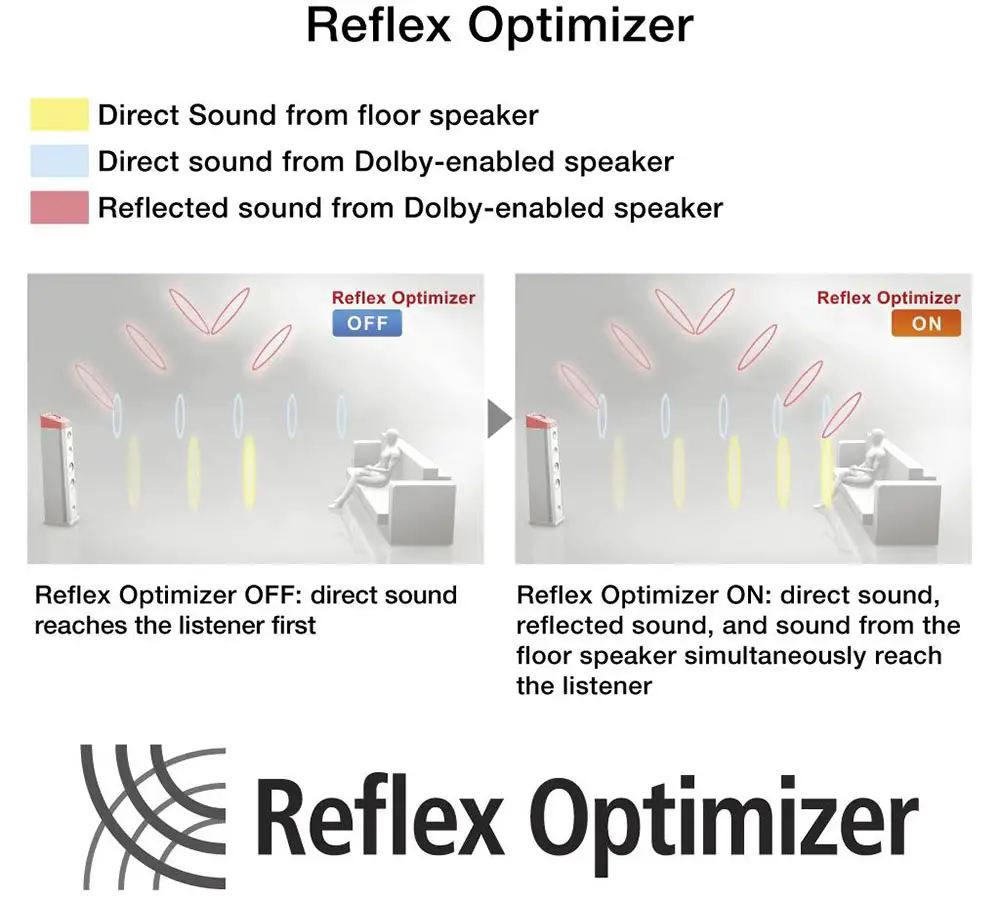
Pioneer has also equipped the receiver with a couple of features in order to improve your audio experience. Firstly there is a Phase Control feature that helps to synchronize the sounds between the main channels and the subwoofer. Due to the phase lag between the two caused by the bass management filter, cancellation occurs between the two channels which can impact the overall audio quality. With Phase Control enabled you get powerful and accurate bass with a matching phase with the main channel.
Another feature is Reflex Optimizer and what does this do is that when using Dolby Atmos-enabled speakers, high directivity sounds from the speakers reflects off the ceiling, while low directivity sounds directly reaches our ears. The different pathways cause a phase shift, making the sound feel uncomfortable and unnatural. The Reflex Optimizer which uses the Phase Control technology adjusts this shift, and improves the localization of the sound image by aligning the frequencies with those of the floor speakers, creating the ideal reproduction environment.
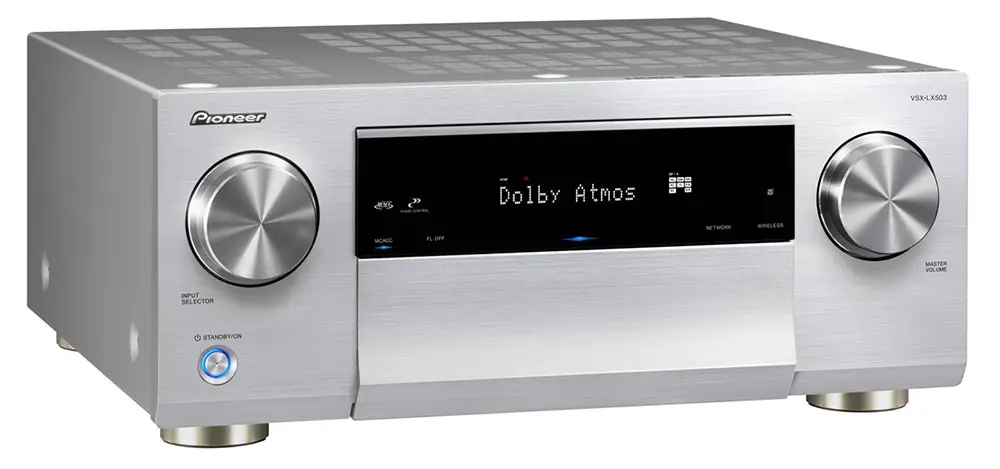
Lastly we should mention that the receiver although a 9.2 channels one can be turned into an 11.2 channels system by using an external amplifier something very useful and a feature that we are sure many prefer than going for a more expensive true 11.2 channels receiver while their prices are still unreachable for most.
Closing our tests we would like to say that we only have good things to say about the Pioneer VSX-LX503. It’s power, channels clear separation, audio quality and performance are really top notch and will leave you happy with it’s capabilities.
Inputs / Ports
The Pioneer VSX-LX503 may be considered a middle tier AV receiver but at this price range we expect to find a wealthy amount of ports that would satisfy not only the entry level enthusiasts but also more hardcore audio fanatics. We have seen in the past receivers with very aggressive prices offering lots of connections and ports, putting pressure on the higher tier models to offer more to justify their price.
With this in mind we see that the VSX-LX503 offers a satisfactory amount of connections both in the front and the back. But is it enough? First of all in the front we get what is considered the standard by having an HDMI in port, a USB port for connecting external storage, a headphones jack and a MCACC port for the setup microphone. All of the frontal ports are hidden inside the front door in order to keep them hidden. The rest of the connections are naturally placed at the back so let’s see what we get here. First of all we have the speakers connectors, enough to create either a 5.2.4 setup or a 7.2.2 setup depending on the configuration you choose. We also get 6 HDMI inputs and 2 HDMI outputs, all of them supporting HDCP 2.2 and able to transfer 4K with HDR signals as well as Dolby Vision.
There is also a satisfactory amount of legacy connections with one component video input, two composite video inputs and five stereo audio inputs. We also get the standard pre-out and zone 2 connections, an RS-232 port,an IR in and out ports, two 12V trigger outputs, one coaxial and two optical digital audio inputs, the usual antenna ports, a USB port and last but not least an Ethernet port for wired connection to the internet.
In general although there are a lot of ports on offer we have seen lowered priced models that we had reviewed before offer much more ports than what the Pioneer one offers. For example the Denon AVR-X3400H, an 7.2 channels receiver that is priced almost $400 less than the Pioneer, offers much more legacy connections as well as three HDMI out ports and seven HDMI inputs. So there is no excuse for the VSX-LX503 to be so shy on offering more ports when we are talking about a $1000 AV receiver.
OS, Apps and Features
Setup menus are pretty straightforward and we had no problems to make all basic connection settings. Calibrating various aspects of the system like position, size, volume and various other speaker settings are done through the on-screen menus and for anyone experienced with such kind of menus it will feel like second nature to go through them.
Pioneer has created their own audio calibration system called MCACC (Multi-Channel Acoustic Calibration System) that they developed with the expertise of professional recording studios. Combined with the included test microphone the system automatically adjusts and compensates for various differences in speaker size, level and distance, and equalizes response. A very useful feature for those inexperienced with such kind of calibrations and want the best possible outcome without the need to dive deep into more advanced settings.
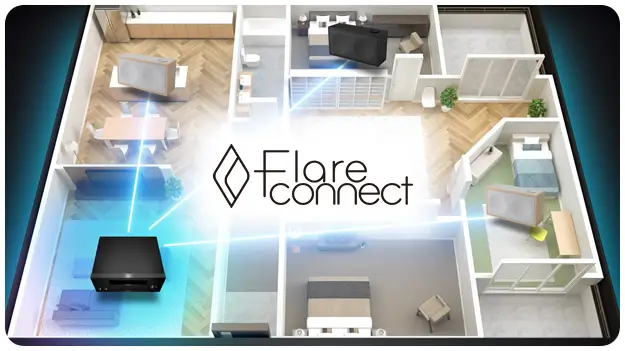
Pioneer VSX-LX503 also supports a wide range of multi-room and streaming features. FlareConnect is a feature that lets you share audio from the network or external audio input sources. This way you can enjoy multi-room playback of LP records, CDs, network music services, and more with supported components and speaker systems. Music selection, speaker grouping, and playback management across the home are built into the Pioneer Remote App that you can download through the App Store or Google Play.
The VSX-LX503 comes with Chromecast built-in, so you can use your mobile device to stream your favorite music, radio, or podcasts to your speaker. Also you have the ability to control the audio from anywhere in the house using Chromecast enabled apps running on your personal device—iPhone, iPad, Android phone and tablet, Mac and Windows laptop, and Chromebook. The VSX-LX503 also works with the Google Assistant, so you can tell it to turn up the volume, skip tracks, or stop the music using your Google Assistant enabled device, like Google Home.
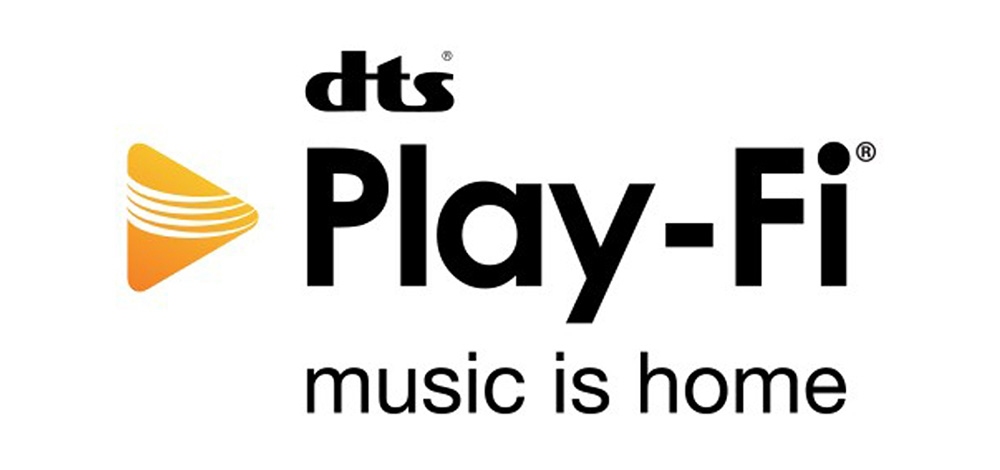
We also get DTS Play-Fi which wirelessly streams any audio content from any compatible mobile device to the VSX-LX503 and DTS Play-Fi compatible audio systems, creating a multi-room system in your home. You can stream different sources to different speakers at the same time from the Pioneer Music Control App which you can download from the internet.
The remote offered with the VSX-LX503 may not be one of the most interesting or functional remotes we have seen in an electronic device but will definitely do the job. What we definitely liked was that Pioneer opted not to clutter the remote with buttons that most of the time will never be used. As a result we get a remote that has very few buttons compared to many other AV receivers and they are just enough for the most basic of functions. The buttons have a nice rubber feel to them but unfortunately there is no backlight functionality.

Buttons are separated into groups and in the top we get the inputs, in the middle a rather nice rhombus shape with menu navigation buttons, under it the most important volume control buttons separated from the rest and at the bottom a few playback and various functions buttons. Having the volume buttons completely separated from the rest is a smart move and one we hadn’t seen before in a remote like this. Definitely a nice design decision.
Final Thoughts
In order for manufacturers to remain competitive they are equipping lower rated models with features we would only find in top rated receivers a few years back. As such we now start seeing 9.2 channels AV receivers costing less than $1000 which only means good things for the consumers.
As such Pioneer VSX-LX503 is following this new trend by offering 9 channels of built-in amplification which can expand to 11 channels with an external amplifier, enough power for a medium sized room, great audio performance and a great array of features to make this receiver a future proof option for everyone that is interested. If you consider that the price is diving under the $1000 psychological barrier then this new model from Pioneer can be considered a very good option.
At the opposite side there are a couple of drawbacks with the amount of connections offered being the biggest as we have seen much lower tier receivers offer more legacy as well as HDMI connections putting the Pioneer receiver a bit on a difficult position. Competition is fierce so manufacturers have to account for everything as just offering an AV receiver with good audio performance is not enough anymore. Also we would like to have some kind of backlight functionality with the otherwise nice remote.
In total we liked this receiver. Pioneer managed to create a nice model that ticks most of the right boxes. It certainly is not perfect and they could do a few things better but if you look at the whole picture the sense you get from the VSX-LX503 is that it is a fine piece of equipment that will definitely give you what you expect and more making it a worthy addition to anyone’s home theater room.
For more reviews you can check our dedicated 9 channels 4K AV Receiver reviews list or even look at our Product Reviews Table where you can find the brand and specific product you are looking for.
Cheapest Places to Buy :
*We are a reader-supported website. When you buy through links on our site, we may earn a small affiliate commission at no extra cost to you. Home Media Entertainment does not accept money for reviews.*
Specifications
- Amplification : 9.2 channel AV Receiver with 120 W/ch (8 ohms, 20 Hz-20 kHz, THD 0.08 %, 2ch Driven, FTC)
- Video Features : Ultra HD Pass-through with HDCP 2.2 (4K/60p/4:4:4/24-bit, 4K/24p/4:4:4/36-bit, 4K/60p/4:2:0/36-bit), HDR10, HLG and BT.2020 Wide Color Gamut Signal Pass-through, Dolby Vision Compatible, Ultra HD Upscaling (1080p to 4K), 3D Ready (Blu-ray Disc™, Broadcast, and Games), Deep Color (36-bit), “x.v.Color”
- Audio Features : Dolby Atmos®, Dolby Surround Upmixer supports DTS Formats, DTS:X®, DTS Neural:X® Upmixer supports Dolby Formats, DSD Direct Playback via Network/USB (11.2, 5.6, 2.8 MHz/2 ch), DSD Disc (SACD) Playback via HDMI (5.6, 2.8 MHz/2 ch, 2.8 MHz/5.1 ch), MCACC Auto Room Tuning, Advanced Sound Retriever (2ch), Advanced Surround Modes, Reflex Optimizer
- Hardware : Digital Quad-Core 32-bit DSP (Cirrus Logic) + Aureus™ Floating-Point DSP (TI), 384 kHz/32-bit D/A Conversion with AK4458 (AKM) & PCM5101 (TI)
- Home Network Features : Multi Zone Music, FlareConnect™ for Multi-room Audio, Chromecast built-in, Works with the Google Assistant, DTS Play-Fi with Pioneer Music Control App, Apple AirPlay Certified, Internet Radio with TuneIn, Hi-Res Audio File Playback via USB/Network, Up to 192 kHz/24-bit ALAC, AIFF, FLAC, WAV (RIFF) and 11.2 MHz DSD, Dolby® TrueHD
- Online Services : Amazon Music, Pandora®, Spotify, TIDAL, and Deezer Music-Streaming Services Ready
- Convenience Features : Powered Zone 3/Zone2, Dual Band (5 GHz/2.4 GHz) Wi-Fi® Built-in, Bluetooth® Wireless Technology (Version: 4.1 + LE, Profile: A2DP 1.2/AVRCP 1.3, Codec: SBC/AAC) Built-in, Pioneer Remote App*4 Ready for Multi-room Entertainment Control and Network Streaming, User-Friendly GUI with System/Network Setup Menu, PC Setup, Auto Power Off in HDMI Standby Through, AM/FM Tuner 40 Presets, Sleep Timer
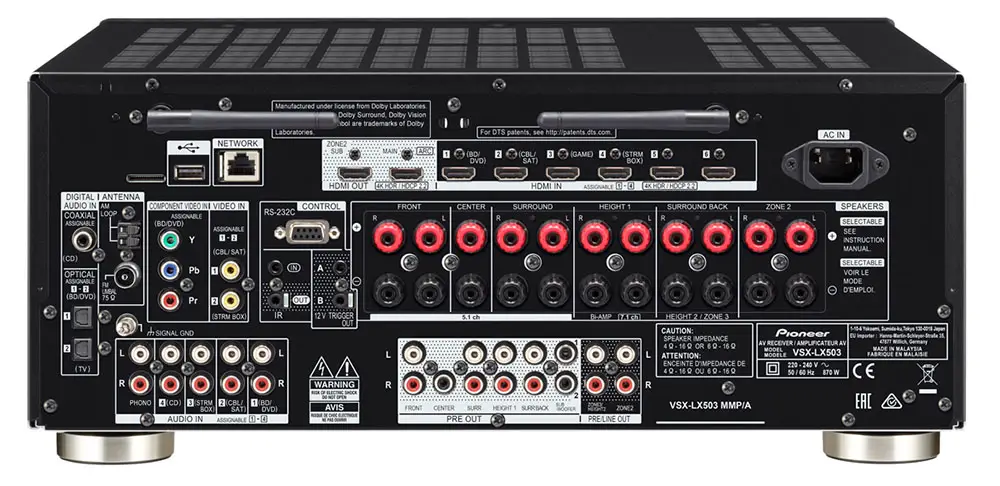
Thanks for the review of the VSX-LX503.
I am just starting to explore the mid range and this does look like an interesting receiver.
How future proof is it?
what remote audio products is it compatable with?
As you say it is interesting that they have not included even ared light backlight on the remote.
How bright is the display on the receiver and is it distracting in a partially lit room?
It does look like a nice piece of kit.
Hello Phil. By supporting all new object-oriented audio formats like Dolby Atmos and DTS:X combined with a huge array of online and offline features that we analyze above this receiver will definitely last you for many years to come. As for the display brightness it has a dimmer setting so you can adjust the display brightness in order not to be very distracting in a low lit environment.
How will you compare Pioneer LX 503 with Marantz SR 6013 in terms of sound quality as both have almost simiy features with edge to Marantz for eleven channels pre out…. Pioneer seems to be on bright side whereas Marantz is on warmer side which speakers will suit the best…
Hello Rajesh. The Marantz has the edge between the 2 as it has more HDMI ports, it supports eARC, Airplay 2, it is IMAX Enhanced ready while it’s calibration system, the Audyssey MultEQ XT32, we believe is a bit better than Pioneer’s MCACC. But one thing you should keep in mind is that the Marantz also costs a lot more with a few stores selling it at double the price of the Pioneer ($1,200 in comparison to $600 of the Pioneer). So if the extra features of the Marantz are not very important you should better go for the Pioneer as the price difference is huge.
Good day Sir,pls am a fan of Onkyo AVR due to its very sharp picture quality display on TV screen..can pls say if this pioneer set has similar picture quality display
Hello Oluseyi. Are you talking about 4K upscaling? Because the Pioneer supports signal pass-through. Please give me a bit more details in order to understand your question.
Hello,
I’m trying to decide if I buy a Pioneer VSX-LX503 or a Denon AVR-X3500H . I own a 13 years old Denon amp and I want to update it. We use it 70% Movies and 30% Music, the room is middle size, 4K TV, and a Sony UBP-X700 4k bluray. I´ll appreciate your advice between this two amps.
Hey Alex. Since both of them seem to have the same price you should go with the one that has the most features as quality wise they are both very good. So let’s see the best point of each one.
The pioneer supports more channels (9.2), has more power at 120 watts and comes with more connectivity and streaming options as it supports ChromeCast, FlareConnect, DTS Play-Fi and Airplay.
The Denon supports less channels (7.2), has less power at 105 watts, supports less connectivity options with only HEOS and Airplay but on the other side it comes with DTS Virtual:X support that the Pioneer doesn’t have and also supports all 4 voice control platforms (Alexa, Google, Siri, Josh.AI) while Pioneer only supports Google Assistant.
From all the above if you would ask me I would go for the Pioneer. The more channels and more power puts the VSX-LX503 in a different category than the Denon and thus is a better value for money option.
Hope I helped you.